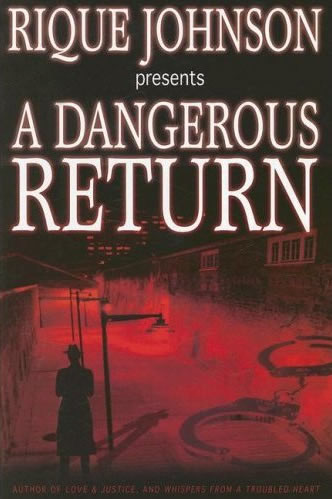 A Dangerous Return, Rique Johnson, Strebor Books, ISBN # 1-59309-043-9, $15. A Dangerous Return, Rique Johnson, Strebor Books, ISBN # 1-59309-043-9, $15.
Love, revenge and betrayal explode into a life-or-death situation in the third installation of Rique Johnson’s engrossing detective series. Detective Jason Jerrard has been relaxing and enjoying the life of his dreams since his retirement. But the sudden death of someone dear to him forces Jason out of his quiet life and back into the police force to investigate the murder. Even as Jason tries to get back into the game, his personal life starts to unravel when Monique objects to his sudden return to the force. And as the case grows more complicated, a killer’s quest for vengeance will force Jason to choose between his head and his heart in order to survive.
 A Pilot’s Journey: Memoirs of a Tuskegee Airman, Curtis Christopher Robinson, George Norfleet, Robnor Publishing, ISBN # 0-976192-0-6, $24.95. A Pilot’s Journey: Memoirs of a Tuskegee Airman, Curtis Christopher Robinson, George Norfleet, Robnor Publishing, ISBN # 0-976192-0-6, $24.95.
Although he is a former 99th fighter squadron pilot and Tuskegee airman, Curtis Robinson says that, by his family’s standards, there was nothing special about him. This memoir takes readers on a 250-year journey into his family’s history. It educates and illuminates, and reminds us that, not so long ago, this country was a different place, one that treated many of its citizens as less than second-class. But while A Pilot’s Journey is never less than honest about the difficulties of being Black in 20th Century America, it also celebrates the way Robinson, his forebears and his contemporaries rose well above the limitations placed on them by the government and their country.
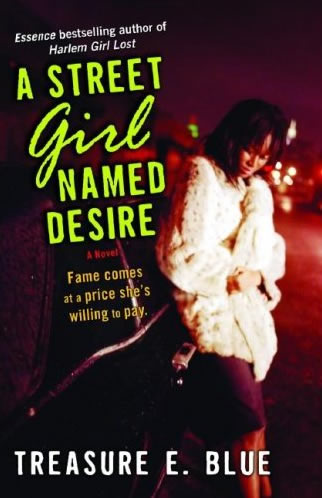 A Street Girl Named Desire, Treasure E. Blue, Ballantine Books, ISBN # 0-345-49328-6, $13.95. A Street Girl Named Desire, Treasure E. Blue, Ballantine Books, ISBN # 0-345-49328-6, $13.95.
Desire Evans was born on the streets of Harlem – literally. Her mom, a crack-addicted prostitute, delivered her on a bitter winter’s night after turning a trick and being beaten by the john. Taken from her mother by the state, Desire grows up among less-than-welcoming foster homes, scraping a living in strip clubs until a local Good Samaritan takes her in. With Miss Hattie Mae’s love and Christian guidance, Desire gains confidence, joins the church choir, and discovers she’s got a set of pipes that soon attracts the attention of hip-hop’s biggest music exec. But the road to super-stardom is lined with dangers and temptations. Despite her phenomenal success and Mss Hattie Mae’s kindness, Desire seems destined for a fall from the top that’ll slam her back onto the pavement where her mama left her – until an unexpected angel picks her back up.
Return To Top
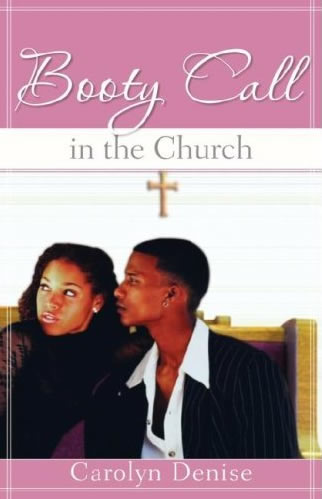 Booty Call In The Church, Carolyn Denise, Xulon Press, ISBN # 1-60266-182-0, $13.99. Booty Call In The Church, Carolyn Denise, Xulon Press, ISBN # 1-60266-182-0, $13.99.
Everyone knows it’s happening, but no one dares to speak about it, until now. “I would love to see you in a swimming suit,” said the married preacher to the single congregant. “Want to be booty partners?” asked the deacon. “Isn’t that your wife in the choir?” the single lady asked. “Yeah, I can explain that…” After 15 years of marriage, Carolyn Denise found herself divorced and in a new category at church – Single Christian. She had no idea how active single Christians were until she became one herself. She was under the impression that they were living what they were shouting about. But as time progressed and the offers from booty chasers continued to flow her direction, Denise learned fast about the leaders who lay hands on their single members. Who does God hold accountable then?
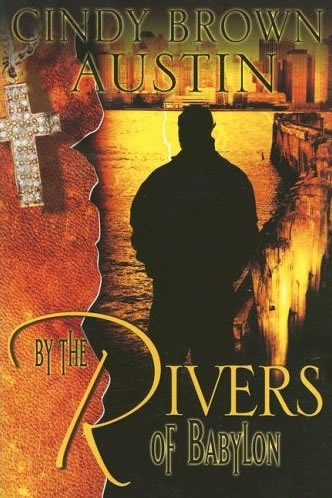 By The Rivers Of Babylon, Cindy Brown Austin, Strebor Books, ISBN # 1-59309-117-6, $15. By The Rivers Of Babylon, Cindy Brown Austin, Strebor Books, ISBN # 1-59309-117-6, $15.
Lincoln Duvall is the Third Ward’s most notorious criminal, a drug lord and known murderer who has sold his soul to the Devil and abandoned his early roots of religious upbringing. But when he falls in love with Gabriella Sinclaire, a street-savvy Christian journalist with the power to reveal his secrets and dismantle his entire organization, good is pitted against evil in a dramatic showdown. Is spiritual redemption possible for Lincoln, or will he pull Gabriella away from her life of virtue down into the darkness of his world?
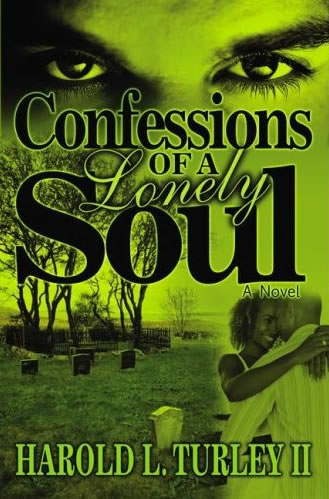 Confessions Of A Lonely Soul, Harold L. Turley II, Strebor Books, ISBN # 1-59309-054-4, $14. Confessions Of A Lonely Soul, Harold L. Turley II, Strebor Books, ISBN # 1-59309-054-4, $14.
DeMarco Reid dies of AIDS and leaves behind a mysterious videotape for his family to play during his funeral, but his family doesn’t realize that they’re in for the shock of their lives. In the video, he exposes his tormented life of secrets and guilt, including why his wife committed suicide, how he contracted HIV, his connection to a murder, and, ultimately, his quest for the meaning of life. But there are two sides to every story. Is DeMarco tell-all actually true, or are there even more shocking secrets threatening to shake this family to its foundations?
Return To Top
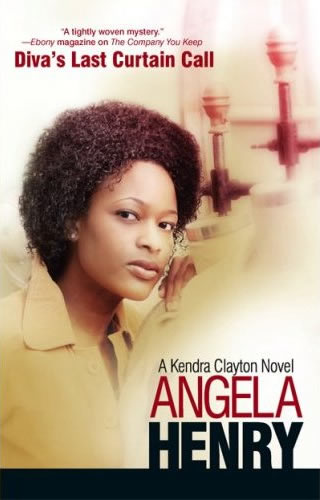 Diva’s Last Curtain Call, Angela Henry, Harlequinn Press, ISBN # 0-3738-3044-2, $14.95. Diva’s Last Curtain Call, Angela Henry, Harlequinn Press, ISBN # 0-3738-3044-2, $14.95.
Despite the recent Oscar successes of Academy Award winners Halle Berry and Jennifer Hudson, a quick scan of the summer’s most anticipated movies shows that African-American actresses still aren’t getting the same casting opportunities as their white counterparts. Mystery author Angela Henry is taking on Hollywood’s discrimination machine in the third novel of her mystery series featuring African-American amateur sleuth, Kendra Clayton. In Diva’s Last Curtain Call, Clayton has to solve the murder of fading African-American actress Vivianne DeArmond in order to clear her own sister, aspiring actress Allegra Clayton. DeArmond is based on screen legend Dorothy Dandridge, the first African-American actress nominated for a best actress Oscar, to raise awareness about the obstacles that Black actresses still face today.
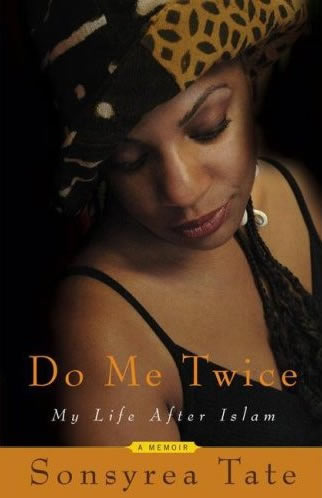 Do Me Twice: My Life After Islam, Sonsryrea Tate, Atria Books, ISBN # 0-59309-122-4, $15. Do Me Twice: My Life After Islam, Sonsryrea Tate, Atria Books, ISBN # 0-59309-122-4, $15.
As a former African-American Muslim, Sonsyrea Tate has raised awareness for that community by bringing personal and enlightening answers to a curious audience: who are African-American Muslims; what do they stand for and why; how far-reaching are their lifestyle choices? With the global focus on terrorism and interest in the Islamic state, Do Me Twice can offer answers that are not influenced by government spin or newscast ratings. This book inspires while exploring Tate’s conscious separation from Islam, her abusive husband, a controlling family, and the prejudices and stereotypes set on her by others’ misconceptions.
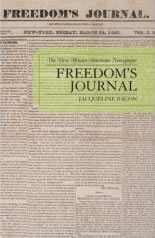 Freedom’s Journal: The First African-American Newspaper, Jacqueline Bacon, Lexington Books, ISBN # 0-7391-1893-1, $29.95. Freedom’s Journal: The First African-American Newspaper, Jacqueline Bacon, Lexington Books, ISBN # 0-7391-1893-1, $29.95.
On March 16, 1827, Freedom’s Journal, the first African-American newspaper, began publication in New York. Despite its significance, until now there has been no comprehensive study of the periodical. Histories of the Black press and studies of the late 1820s have considered it only briefly, at times making assumptions about it – its founding, its focus, its goals, and its editors – that overlook important facts, neglect to fully account for its richness and depth, and leave significant questions unanswered. This book is the first study to examine this groundbreaking periodical comprehensively, both by creating a detailed history of the newspaper and those associated with it, and by mining its columns for the wealth of information they provide about African-American life and perspectives in the late 1820s, a key period of Black community development and activism.
Return To Top
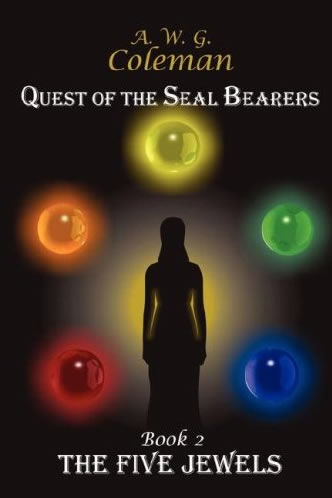 Quest Of The Seal Bearers, The Five Jewels, Alan Wayne-Grant Coleman, VirtualBook.com, ISBN # 1-6026-4011-4, $15.95. Quest Of The Seal Bearers, The Five Jewels, Alan Wayne-Grant Coleman, VirtualBook.com, ISBN # 1-6026-4011-4, $15.95.
The second book in the Quest of the Seal Bearers series, The Five Jewels, follows the events on the planet Mendala after a group of teenagers from Earth have won their first victory against the tyrant Davron and the monsters he created with the Book of War. These young heroes bear the mark of the seals, and are the only ones who can defeat the normally indestructible creatures. Now they must obtain a set of artifacts, known as the five jewels, before Davron and his creatures can. Whoever has the jewels can shift the balance of power. But with one of the teens now working at Davron’s side, who will be the first to gain control?
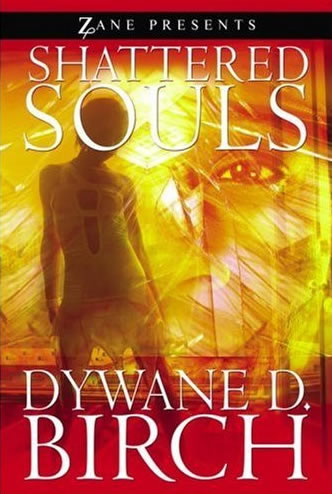 Shattered Souls, Dywayne D. Birch, Strebor Books, ISBN # 1-59309-110-9, $14. Shattered Souls, Dywayne D. Birch, Strebor Books, ISBN # 1-59309-110-9, $14.
Since meeting in college, Britton, Indera, Damascus and Chyna have each gone on to success and acclaim. But beneath the surface, all four are struggling with demons, striving to mask the deep emotional wounds they sustained long ago. As repressed childhood memories creep back into their lives to haunt and control them, and carefully tested veneers begin to crack, the bonds of their friendship are tested like never before. In candid, raw prose, Dywayne Birch explores the potentially devastating consequences of childhood abuse and mistreatment, but also pays tribute to human courage and perseverance in a heartfelt, unforgettably powerful novel.
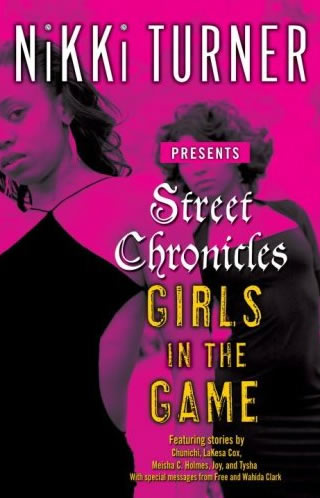 Street Chronicles, Girls In The Game, Nikki Turner, Ballantine Books, ISBN # 0-345-48402-4, $13.95. Street Chronicles, Girls In The Game, Nikki Turner, Ballantine Books, ISBN # 0-345-48402-4, $13.95.
A collection of explosive stories hand-picked by the undisputed queen of hip-hop fiction, Girls in the Game presents an all-women crew of urban-lit divas. The game here is survival, and every ghetto-hardened gangsta in these tales does what she’s gotta do to make it on – or off – the mean streets. Call them what you will, but until you’ve faced their reality, you’ll never know what you would do if you were in their pumps. Just remember: it’s a dirty game, and women are usually the best players.
Return To Top
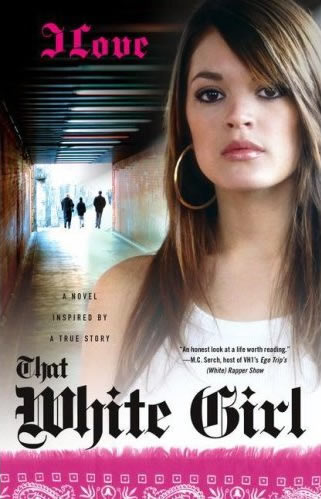 That White Girl, JLove, Atria Books, ISBN # 0-7432-8781-9, $14. That White Girl, JLove, Atria Books, ISBN # 0-7432-8781-9, $14.
The harsh and gritty gang life is a dark world that most people would not dare enter. In this harsh and intensely moving coming-of-age novel, Amber, a white, middle-class, Irish Catholic teenager from Denver, finds herself involved with the notorious Crips when she is asked to hold a gun to a man’s head during a robbery. The adrenaline rush and power of sudden violence entices her senses, and she becomes swept up in the allure of gangs and street life. Written from experience, That White Girl explores a young girl’s struggles and triumphs as she crosses into territory unknown to her, discovers her own limits, and finds a new way of expressing her inner voice in a society divided by the color of your skin.
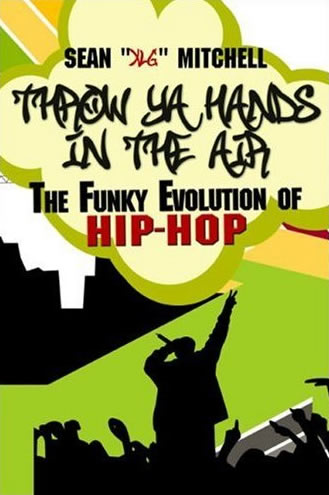 Throw Ya Hands In The Air: The Funky Evolution Of Hip Hop, Sean “XLG” Mitchell, PublishAmerica, ISBN # 1-4241-6754-X, $14.95. Throw Ya Hands In The Air: The Funky Evolution Of Hip Hop, Sean “XLG” Mitchell, PublishAmerica, ISBN # 1-4241-6754-X, $14.95.
Throw Ya Hands in the Air is not just a rallying call in the world of hip-hop anymore. This book chronicles the year-by-year rise of rap music since its inception on the music scene to becoming a multi-billion dollar industry. Highlighting such notable acts as the Sugar Hill Gang, Run-D.M.C., and Salt-N-Pepa, to name a few, Throw Ya Hands in the Air details the evolution of one of the most intriguing art forms to date. XLG details classic MC battles and memorable events by taking us back to the day when we danced the wop and screamed, “the roof is on fire!” This book is a one-and-only classic and a must-read for hip-hop fans.
 Want A Man? Let’s Talk, Toria Wyrick, AuthorHouse, ISBN # 1-4259-9351-6, $12.50. Want A Man? Let’s Talk, Toria Wyrick, AuthorHouse, ISBN # 1-4259-9351-6, $12.50.
Toria Wyrick supplies single women with a practical guide to prepare for, find and experience more meaningful relationships with men in her new book, Want a Man? Let’s Talk. This book is a practical approach to mentally and emotionally prepare women for relationships. Wyrick says that women need to be ready when they cross paths with their soul mate, and she teaches them how to find success in this quest for love. Women will explore their past to resolve emotional concerns, remove barriers, and unpack any excess baggage from previous relationships.
Return To Top
Book Reviews By Kam Williams
African American History For Dummies, Ronda Racha Penrice, Wiley Publishing, 432 pages, ISBN # 0-7645-5469-8, $19.95.
African-American history, to be clear, is so much more than a handful of extraordinary individuals or practices like slavery, Jim Crow, and civil rights. A lot of it is painful, but it’s also inspiring and triumphant... It took the Civil War, the civil rights movement of the 1960s, and a lot of struggle in between to secure African-Americans the basic right to citizenship that white Americans took for granted.
[This book] isn’t a big sermon on the struggle; instead, it’s a straightforward, interesting (I hope!), and honest overview of African-American history from Africa through the transatlantic slave trade, slavery, the Civil War, Reconstruction, Jim Crow, and the 1960s civil rights movement until now. Along the way, that history birthed a culture that includes the black church and education as well as sports, music, literature, television, and film.
--Excerpted from the Introduction
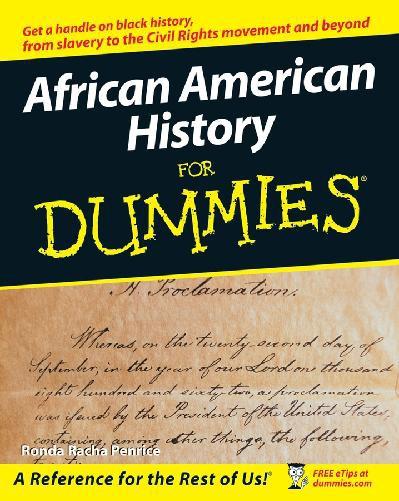 I majored in Black studies in college, way back when the new field of study was still generally being dismissed as a joke or, at best, as undeserving of being the focus of extensive scholarly research. So, my interest was particularly piqued by the publication of this book for a few of reasons. I majored in Black studies in college, way back when the new field of study was still generally being dismissed as a joke or, at best, as undeserving of being the focus of extensive scholarly research. So, my interest was particularly piqued by the publication of this book for a few of reasons.
First, I wondered whether the subject matter would be presented in a serious and dignified fashion, given the “for Dummies” subtitle. Secondly, I was curious about how comprehensive the text would be, and whether the author would even be able to address most of the significant events in African-American history in a work of just over 400 pages. And finally, and perhaps most importantly, I wanted to get a sense of the opus’ point of view, since there’s a big difference between talking about memorable milestones from the perspective of the victims of racism and that of the perpetrators.
The good news is that African American History for Dummies passes the first two tests with flying colors. The tome is encyclopedic in scope, yet surprisingly engaging in tone, being written by someone with a gift for serving up a chronological collection of facts on a zillion different topics in a lyrical style that sounds downright conversational. Credit for achieving this feat goes to author Ronda Racha Penrice, a Columbia University graduate who has served as an editor at the Quarterly Black Review, and who has written for such publications as Essence, AOL Black Voices, Vibe and Africana.com.
Where I do take issue with her otherwise praiseworthy approach are on the rare occasions that she seemingly attempts to be on both sides of the fence when discussing hot button issues, such as the N-word (“Slaves sometimes referred to themselves as ‘niggers.’”) and the Dred Scott Decision (“The Supreme Court decided that, because Scott was African American, he wasn’t a citizen and therefore couldn’t sue anybody.”).
By trying hard not to offend anyone in the above quoted entries, Ms. Penrice risks, in the first instance, misleading impressionable young minds into believing that the N-word was a slur first used by Blacks. As for Dred Scott, the actual ruling unequivocally deemed African-Americans, “beings of an inferior order, and altogether unfit to associate with the white race, either in social or political relations, and so far inferior that they had no rights which the white man was bound to respect," a far crueler declaration than the author’s relatively benign interpretation.
Thus, African American History for Dummies is recommended reading for those who would prefer the truth at times tempered by euphemisms that appear intended to make the ordeal endured by Blacks in this country over the ages sound a lot less monstrous than it undoubtedly was. The historical equivalent of smooth jazz.
Return To Top
An Illuminated Life: Belle Da Costa Greene’s Journey From Prejudice To Privilege, Heidi Ardizzone, W.W. Norton & Company, 616 pages, ISBN # 0-393-05104-9, $35.00
Princeton University was a particularly interesting place for Belle to first be on her own and living as white... Princeton was culturally very southern despite its northern location, and the university was largely responsible for this.
Throughout the 19th C. Princeton had drawn its upper-class male student body, as well as much of its faculty and administration, primarily from the slaveholding South… Students even brought slaves with them as personal servants during their school residency. Moreover, Princeton was the only Ivy League school that had not begun to admit any African-American students by the turn of the 20th C.
In Princeton, segregation was institutionalized in practices of discrimination and exclusion… hotels and restaurants barred African-Americans… African-American children could only attend a black grammar school; there was no black high school. In other words, Princeton operated with exactly the kind of two-tiered racial segregation that made it virtually impossible to maintain a mixed-race identity in public…
[Therefore] living in Princeton would have tested any continued connection [Belle] may have felt with the black community.
--Excerpted from Chapter Three, Princeton (pgs. 65, 66 & 69)
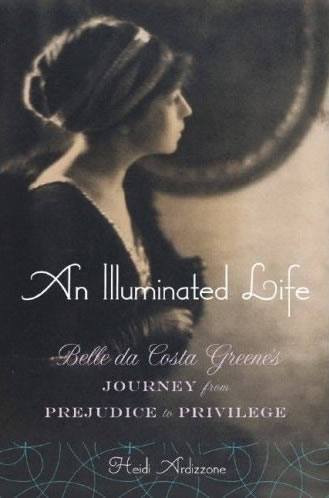 Most African-Americans of my generation were raised with whispered rumors about light-skinned relatives who had opted to pass for white. Sadly, due to the United States’ virulent strain of racism, this often meant that one might never see or hear from that crossing over sibling, cousin, son or daughter again, given the sick society’s strictly-enforced system of segregation. Most African-Americans of my generation were raised with whispered rumors about light-skinned relatives who had opted to pass for white. Sadly, due to the United States’ virulent strain of racism, this often meant that one might never see or hear from that crossing over sibling, cousin, son or daughter again, given the sick society’s strictly-enforced system of segregation.
For this reason, a book like the aptly titled An Illuminated Life represents a priceless addition to the annals of African-Americana, for it represents a very revealing and detailed biography of a woman who made just such a daring transition. Belle Marian Greener (1883-1950) was born in Washington, DC to parents who were both Black. Her father had been the first African-American to graduate from Harvard while her mother hailed from a prominent Black family that had been emancipated for generations.
It is important to note that “during Reconstruction and the 1880s,” [Black people] “had faith that the race would be assimilated into white society.” Thus, “the dramatic rise of racism in the 1890s came as a great shock to the Black elite.” Since Belle came of age during that repressive era of redneck backlash, the country’s sudden reversion to an ante bellum agenda helps explain her behavior when she came of age to move into the world on her own.
Changing her name to Belle da Costa Greene, she proceeded to claim to be part Portuguese, as a means of explaining her olive complexion. She moved to Princeton, New Jersey where, now as a white woman, she landed the position as a librarian, which would lead to an enviable career as the curator of the manuscript collection of industrialist J.P. Morgan, who had amassed a fortune as a Civil War profiteer.
Author Heidi Ardizzone, Professor of American Studies at Notre Dame, does a marvelous job of making her mysterious subject come alive here, given the dearth of material available. For Belle was understandably furtive about her life, “destroying personal papers” and “maintaining different public and private personas.”
Though she never married, she is known to have kept the company of several very powerful men considerably above her station, and to have felt very comfortable moving among New York City’s wealthy and well-connected. One can only imagine how much more bohemian Belle might have blossomed and indulged her glamorous side, if she didn’t have to look over her shoulder constantly, wondering whether her roots might come back to bite her.
Simply, a fascinating must-read.
Return To Top
Ralph Ellison: A Biography, Arnold Rampersad, Alfred A. Knopf, 686 pages, ISBN # 0-375-40827-4, $35.
I know by now that all my little triumphs are in reality defeats.
--Ralph Ellison, 1961
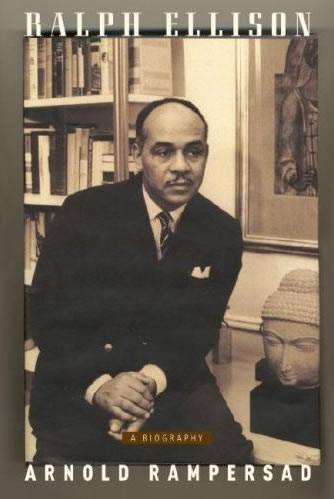 When Ralph Ellison (1913-1994) won the National Book Award for Invisible Man in 1953, little did he know that he’d never publish another novel during his lifetime. Still, his acerbic examination of racism through the eyes of a Black man in search of an identity was a masterpiece that permanently established the author in the pantheon of great African-American writers on the strength of this contribution alone. When Ralph Ellison (1913-1994) won the National Book Award for Invisible Man in 1953, little did he know that he’d never publish another novel during his lifetime. Still, his acerbic examination of racism through the eyes of a Black man in search of an identity was a masterpiece that permanently established the author in the pantheon of great African-American writers on the strength of this contribution alone.
Ellison, a World War II veteran and college dropout, would spend the next 40 years in a futile quest to replicate the success of that literary feat. According to his biographer, Arnold Rampersad, all the attention and accolades that arrived in the wake of Invisible Man probably prevented the perfectionist from ever focusing on his work to the degree necessary to attain the same level of excellence again.
Rampersad, professor of English at Stanford University, devotes almost 700 pages to chronicling his subject’s confounding spiral towards irrelevancy, if not obscurity. Fortunately, this encyclopedic examination of the enigmatic Ellison’s life proves to be fascinating, partially because Ralph was so outspoken and given to making controversial, conservative remarks which ultimately left him ostracized by and estranged from the community he had once so eloquently spoken for.
A Black beatnik still banging on his bongo, Daddy-o, long past the time when his people had begun marching to the beat of a different drum.
Return To Top
Supreme Discomfort: The Divided Soul of Clarence Thomas, Kevin Merida and Michael A. Fletcher, Doubleday, 448 pages, ISBN # 0-385-51080-6, $26.95.
[Clarence] Thomas once said he would never accept a race-based job, and yet he spent an entire federal career in such positions… The irony is that the career path that led him to the most prestigious tenured position in America is one he discourages other blacks from taking... Even as Thomas goes about his work, it’s his racial identity that most defines him. Would he even be on the court if he were not black?
Race remains an inescapable factor in most black lives, no matter how successful or disappointing they have turned out to be. Even in his cloistered, rarefied world as a member of the most important judicial body in existence, Thomas will always be black, and he knows it. Not just black, but black before everything else.
--Excerpted from the Prologue (pg. 6)
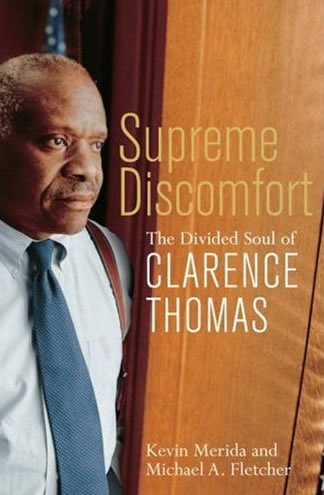 Even if Clarence Thomas weren’t a self-hating Uncle Tom, he would have had a hard time trying to fill the shoes of Justice Thurgood Marshall, a Black man who had risked his life by mounting legal battles to dismantle the Jim Crow system of segregation all across The South, winning the landmark Brown vs. Board of Education case, before later ascending to the Supreme Court as an elder statesman. About all that Clarence the clown had going for him on his spotty resume’ was the fact that he was a well-connected, right-wing bureaucrat who was willing to be promoted or wheeled out for a photo op whenever Republicans needed a Negro yes-man. Even if Clarence Thomas weren’t a self-hating Uncle Tom, he would have had a hard time trying to fill the shoes of Justice Thurgood Marshall, a Black man who had risked his life by mounting legal battles to dismantle the Jim Crow system of segregation all across The South, winning the landmark Brown vs. Board of Education case, before later ascending to the Supreme Court as an elder statesman. About all that Clarence the clown had going for him on his spotty resume’ was the fact that he was a well-connected, right-wing bureaucrat who was willing to be promoted or wheeled out for a photo op whenever Republicans needed a Negro yes-man.
It didn’t help his image any that during his appointment hearings, Anita Hill, a former protégé, would make a very credible witness testifying about the sexual harassment she experienced at his hands during the period she was employed by him. But the Senate being the lily-white, male boys’ club that it was, his nomination was approved, thereby enabling the possibly-perverted jurist to sit on the country’s highest court for life.
Supreme Discomfort: The Divided Soul of Clarence Thomas is an unauthorized biography that seeks to set the record straight about some of the nagging questions about a man whose name alone tends to raise the blood pressure of the average African American. Like a Black version of Woodward and Bernstein, co-authors Kevin Merida and Michael A. Fletcher, both reporters for the Washington Post, left no stone unturned in search of the truth about this enigmatic political figure.
Much of what we learn here is not much of a surprise, like the fact that Anita Hill was telling the truth after all, and that Thomas is an intellectual lightweight who never voices his own opinion in open court, but rather simply takes his cues from his arch-conservative colleague Antonin Scalia.
Apparently, he does have his positives, witnessed in private, such as his serving as a surrogate father to the son of a nephew serving 30 years in prison. But that barely makes up for his willingness to rubber-stamp the efforts of his fellow Republicans on the Supreme Court to overturn all the hard-fought, historic civil rights decisions of the 50s and 60s.
A brilliant bio of a baffling hypocrite who revels in eliminating those equal protection measures which had afforded him his opportunity to make it in a society that had previously been perfectly comfortable completely marginalizing people who looked like him.
Return To Top
We Gotta Have It: Twenty Years of Seeing Black at the Movies, 1986-2006, Esther Iverem, Thunder’s Mouth Press, 640 pages, ISBN # 1-56025-916-7, $17.95.
We Gotta Have It represents twenty years of seeing a new generation of Black movies. Before this journey began in 1986, with Spike Lee’s She’s Gotta Have It, a Black movie meant one of the increasingly mindless productions starring comedians Richard Pryor or Eddie Murphy…
Twenty years later, this era of film has created an explosion in the number of people recognized as Black movie stars. At the same time, there has also been a relative explosion of Black Film auteurs- director-producer-writers who, though toiling increasingly in the obscurity of the film festival circuit, have created and brought to the screen a fuller panorama of Black life.
What has happened between these two points in time is an amazing film journey referred to as the ‘new wave’ of black film… Included here are reviews, (many excerpted), interviews, and essays about movies that we sort of claimed as ours… Movies bring words and images to us but we also bring who we are to the movies- to laugh, to cry, to tremble with fear, to gaze in awe, to grow angry, to contemplate, and, hopefully, sometimes to learn and grow.
We do keep bringing ourselves to the movies in droves. It seems we gotta have it.
--Excerpted from the Introduction (pg. xxvii-xxx)
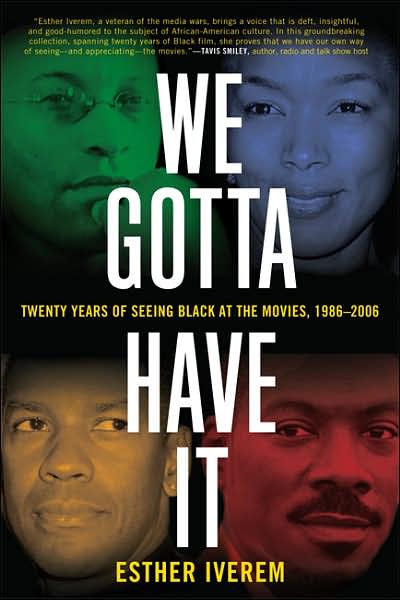 African Americans comprise about a quarter of the domestic movie-going audience, which translates to over $2 billion at the box office alone. For this reason, one would think that Blacks would exert considerable influence over the images of them fashioned by Hollywood. But according to Esther Iverem, despite the significant inroads made since Spike Lee’s arrival on the scene in 1986, the film industry has a long way to go in terms of presenting authentic African-American characters. African Americans comprise about a quarter of the domestic movie-going audience, which translates to over $2 billion at the box office alone. For this reason, one would think that Blacks would exert considerable influence over the images of them fashioned by Hollywood. But according to Esther Iverem, despite the significant inroads made since Spike Lee’s arrival on the scene in 1986, the film industry has a long way to go in terms of presenting authentic African-American characters.
Iverem, a former staff member at the Washington Post and Newsday, is an iconoclastic film reviewer who writes from a point-of-view that is both Black and female. We Gotta Have It is a collection of her insightful reviews, evocative essays and groundbreaking interviews with everyone from Spike to actors Vin Diesel and Danny Glover to author Alice Walker to director Julie Dash.
This book is worth the investment just for the opening chapter alone, in which the author assesses the predicament of Blacks in the U.S. through the prism of motion pictures. There, she asks, “Why does a police officer feel he can get away with sodomizing us with a broomstick; shooting us, as we stand unarmed, forty or fifty times; or beating us bloody on a crowded New Orleans street?”
She alleges that the answer rests with “the cinematic power of turning lies into truth.” For the dominant culture presumes to know Black people as a consequence of watching flicks like Monster’s Ball, for which Halle Berry won an Academy Award. However, Esther suggests that that accolade might have had a lot more to do with Halle’s fulfilling white male fantasies than her portraying a recognizably realistic African-American female.
Ms. Iverem concludes it is “the least attractive, the most criminal, the most seedy part of us, that is then made to become representative of us all.” Such astute observations abound in the aforementioned intro, and only lay the groundwork for the cornucopia of pithy comments contained in the chronologically-arranged entries which ensue.
On Soul Plane: “How many different ways can a film call me a nig. Will we ever learn the difference between a film laughing with us, rather than laughing at us?”
On Monster’s Ball: “Tries to convince us, in a raw, depressing Southern Gothic style that a Black woman in a small Georgia town will turn to a white man, who is an open racist, for sexual comfort and companionship.”
On 8 Mile: “Blacks make an issue of race. B-Rabbit never does, and neither do the trailer park white people he comes from. How real is that?”
On The Last King of Scotland: “It goes on, based on who knows what, to picture African women as easy and available sexual partners… What looks deceptively like history writ large on the big screen turns out to be, partly, some white boy’s wet dream.”
A critic who can skewer so succinctly and delightfully is rare enough indeed, but when you couple that talent with an uncompromising, unique Black feminist perspective, now you’re talking about a sister with a seminal voice deserving of much wider recognition.
Return To Top
Wonderful Ethiopians of the Ancient Cushite Empire, Book II: Origin of Civilization from the Cushites, Drusilla Dunjee Houston, edited by Dr. Peggy Brooks Bertram, Peggy Bertram Publishing, 294 pages, ISBN # 0-9722977-3-1, $24.99.
Arguably, Drusilla Dunjee Houston was one of the most important African-American women writers of the 20th Century and certainly of the American West. She was a multi-faceted figure, who, at one time or another during her wide-ranging career, was an educator, self-trained historian, elegist, club woman, Racial Uplift ideologist and journalist.
Her writings spanned several literary periods, including the race writers, the Black Women’s Era, (1890-1900), and the Harlem Renaissance… Yet, in spite of more than four decades of voluminous writings, both published and unpublished, including editorials, pamphlets, poetry, elegy, screenplays and historical texts, Dunjee Houston remains one of the most overlooked African-American women writers in history… I offer this publication as an eternal libation to one of our most worthy ancestors.
--Excerpted from the Editor’s comments (pg. xlii)
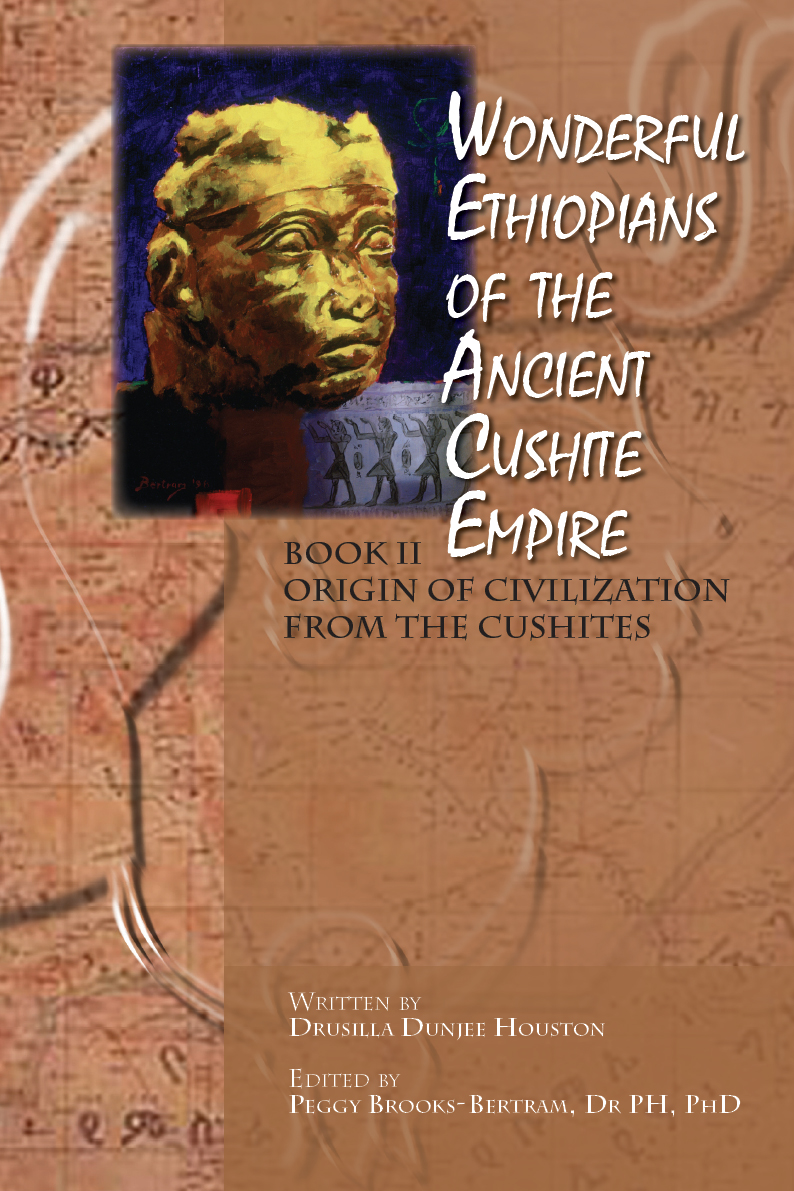 Have you ever heard of Drusilla Dunjee Houston (1876-1941)? Honestly, neither had I, before reading the very informative, annotated biography by historian Dr. Peggy Brooks Bertram, which serves as an extended introduction to Wonderful Ethiopians of the Ancient Cushite Empire. We learn therein that the author was a very prolific writer and a regular contributor to the editorial page of the Oklahoma Black Dispatch for more than a quarter century. Have you ever heard of Drusilla Dunjee Houston (1876-1941)? Honestly, neither had I, before reading the very informative, annotated biography by historian Dr. Peggy Brooks Bertram, which serves as an extended introduction to Wonderful Ethiopians of the Ancient Cushite Empire. We learn therein that the author was a very prolific writer and a regular contributor to the editorial page of the Oklahoma Black Dispatch for more than a quarter century.
And although she didn’t have a college degree, Dunjee Houston did not allow herself to be intimidated by colleagues with impressive credentials. Instead, she embarked on a serious career dedicated to serious academic research, with the aim of unearthing proof of a noble and rich African past in order to refute the conventional wisdom of the day, which dismissed Blacks as a “backward race.”
After seeing such nonsense in one of her daughter’s school books, she decided that the best hope for undoing the damage rested with Blacks researching and then writing an accurate version of their own history. The upshot of her efforts to this end was Wonderful Ethiopians of the Ancient Cushite Empire, a seminal contribution to the annals of African-American literature.
The previously unpublished Book II: Origin of Civilization from the Cushites is comprised of 39 enlightening chapters of generally genealogical analyses of the origins of the Nubian, Ethiopian, Egyptian and numerous other ancient civilizations. In sum, between the bio of Dunjee Houston by Dr. Bertram and the still relevant history lessons that ensue, Wonderful Ethiopians of the Ancient Cushite Empire makes for an excellent alternative to misguided mainstream notions about African cultures.
Plus, perhaps most significantly, it also belatedly sheds some light on an almost-forgotten role model deserving of wider recognition and further study.
Return To Top |
